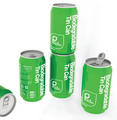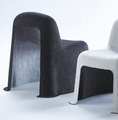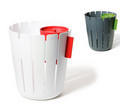Carnivorous Furniture Eats Insects and Vermin to Generate Energy
by: Inhabitat , 2011-02-14 19:14:55 UTC

British designers James Auger and Jimmy Loizeau have devised a series of unsettling furnishings that are sure to split the field when it comes to defining “green design”. These mechanized contraptions feature microbial fuel cells that generate power from fallen vermin – namely mice and insects. The animal lovers among you may not wish to read on, but it is a unique idea if your apartment has a vermin infestation.







Read the rest of Carnivorous Furniture Eats Insects and Vermin to Generate Energyhttp://www.inhabitat.com/wp-admin/ohttp://www.inhabitat.com/wp-admin/options-general.php?page=better_feedptions-general.php?page=better_feed
Permalink |
Add to
del.icio.us |
digg
Post tags: Auger Loizeau, carnivorous furniture, DIY, fly eating clock, fly powered clock, hack, insect eating clock, James Auger, Jimmy Loizeau and Alex Zivanovic, meat eating furniture, modified furniture, mouse eating table, vermin furniture
Global solar power growth doubled in 2010: study
by: Reuters: Green Business News, 2011-02-14 19:49:55 UTC
LONDON (Reuters) - The world added about 16 gigawatts of new solar photovoltaic (PV) power in 2010, double the growth seen a year earlier, the European Photovoltaic Industry Association told Reuters...
 Integral Sustainable Design: A Transformative Perspective
Integral Sustainable Design: A Transformative Perspective
by: Sustainable Design News, 2011-02-08 22:35:00 UTC
 |
Integral Sustainable Design: A Transformative Perspective offers practical and theoretical tools for more effective sustainable design solutions and for communicating sustainable design ideas to today's diverse stakeholders.
It uses Integral Theory to make sense of the many competing ideas in this area and offers a powerful conceptual framework for sustainable designers through the four main perspectives of: Behaviors, Systems, Experiences and Cultures.
 |


Australia plans carbon tax from 2012: report
by: Reuters: Green Business News, 2011-02-12 04:46:46 UTC
SYDNEY (Reuters) - Australia's Labor-led government plans to introduce a fixed carbon price from July 1, 2012 with a compensation scheme for some industries, the Australian newspaper reported on...
 Apparel Companies of All Stripes Come Together to Test the Eco Index
Apparel Companies of All Stripes Come Together to Test the Eco Index
by: Greener Design, 2011-02-05 05:25:13 UTC
The Eco Index, launched last summer by a coalition of companies in the apparel industry, is shaping up to be a useful tool for companies across the spectrum, from wool socks to haute couture.

 The Paradox of Sustainable Innovation
The Paradox of Sustainable Innovation
by: Greener Design, 2011-02-08 19:42:01 UTC
Why does no fully sustainable product exist yet? The answer lies in the most crucial aspect of innovation that people usually forget: people.

 14 Reasons Green Chemistry Works for Companies
14 Reasons Green Chemistry Works for Companies
by: Greener Design, 2011-02-10 19:25:17 UTC
The new Safer by Design report looks at how 14 companies have benefitted from using green chemistry in making products and manufacturing processes.

 Safer by Design
Safer by Design
by: Greener Design, 2011-02-10 19:29:52 UTC
Environment America shows how 14 companies are using green chemistry in products, manufacturing processes and facilities.

 The Toxic Tradeoff: What Happens When Some Products Go Green
The Toxic Tradeoff: What Happens When Some Products Go Green
by: Greener Design, 2011-02-11 12:00:00 UTC
As the movement toward eco-friendly technologies continues, it's critical for products that are marketed as green or non-toxic cleaners to be held to higher standards of transparency regarding their efficacy as well as their ingredients -- so consumers understand what they'e buying, what it's made of and how it works.

 Can a PepsiCo-Powered Crowd of Scientists Rescue Moms and Infants From Malnutrition?
Can a PepsiCo-Powered Crowd of Scientists Rescue Moms and Infants From Malnutrition?
by: fast company, 2011-02-11 14:57:46 UTC

Last November, Scientists Without Borders underwent a makeover from a social networking site for scientists to an open innovation platform that crowdsources solutions to scientific problems. The first major challenge, sweetened by $10,000 in PepsiCo-funded prize money, is reducing infant mortality in the developing world through better nutrition.
Infant mortality in many developing countries is high (3.6 million children dying each year in the neonatal period), but it could easily be averted by reducing the deficiencies of micronutrients (i.e. folic acid) in women of childbearing age. Folic acid is available in supplements and pre-made foods in developed countries, but that's not the case elsewhere. Scientists were being asked to develop an at-home or community-based method for women to safely, easily, and affordably fortify staple foods with folic acid--without requiring major cultural or behavioral changes.
The challenge stopped accepting solutions in November, and now an advisory panel of three leading nutrition scientists is picking from 51 of the best entries, which came from all over the world--including 22 entries from the the Global South (Africa, Asia, Central and Latin America). "We're tapping into communities not usually engaged in these processes," says Shaifali Puri, Executive Director of Scientists Without Borders.
The advisory panel is in the final stages of review, and a winner will be announced next month. Scientists Wihout Borders is already in talks to develop more partner-funded challenges, perhaps related to medicine, agriculture, or water.
In the next few months, the organization also hopes to create its own fund to highlight user-generated challenges--"a competition mechanism to put money behind what we think is the most compelling challenge on the site in a given month," says Puri. As it stands, Scientists Without Borders doesn't offer prizes to members who submit responses to user challenges.
The next step is bringing the most useful responses to life. As Puri explains, "That's a longer-term process."
Follow Fast Company on Twitter. Ariel Schwartz can be reached by email.



Material VOC's cleaning and humidity controlling tiles published.
by: Design 4 Sustainability, 2011-02-26 02:52:50 UTC
ECOCARAT tiles, made by INAX known for it's paperless toilet, contains a mineral "Allophane". It's natural clayey mineral contained in the volcanic ...
Product Reusable, resealable and biodegradable can published.
by: Design 4 Sustainability, 2011-02-25 01:47:06 UTC
The Biodegradable TinCan is a green resolution for the future.
* Thermal double wall: it is safe for serving hot and cold drinks. You can microwave ...
Product Tile kitchen minimizes number of materials published.
by: Design 4 Sustainability, 2011-02-22 00:21:38 UTC
This kitchen brings back into view everything that one normally hides away these days. It thus contrasts a lot with the usual modern-design kitchen ...
Product Customizable lamp published.
by: Design 4 Sustainability, 2011-02-19 09:51:41 UTC
This product changes the user into a co-designer. It comes in a flat pack and can be changed into any shape, again and again. The shade can take whatever ...
Product Chairs designed for its life cycle published.
by: Design 4 Sustainability, 2011-02-18 05:19:49 UTC
With colored polypropylene bodywork and recycled-steel trestles, the chairs in the Catifa 53 and 46 collections may look like any other chair but ...
Material Bionic tiles are cleaning airpolution published.
by: Design 4 Sustainability, 2011-02-18 04:23:08 UTC
BIONICTILE ® by CERACASA is a porcelain tile with the capacity to destroy harmful nitrogen oxides (NOx) which are in the air. These NOx are present ...
Product SL17 BASKETBIN separating waste published.
by: Design 4 Sustainability, 2011-02-17 01:37:56 UTC
SL17 BASKETBIN is a waste-paper basket with a small integrated rubbish bin, which is hooked into the mounting of the larger waste-paper basket and ...










Comments by our Users
Be the first to write a comment for this item.